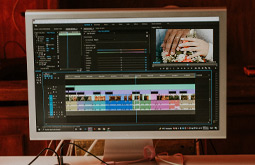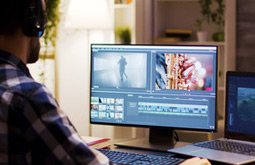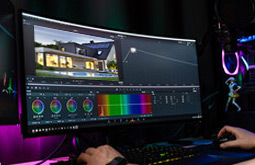11 Different Types of Video Editing (+ 2025's Trending Styles)
Video shooting and video editing go hand in hand. Doesn’t matter if you are a professional photographer, daily YouTube vlogger, or a social media influencer; you want your videos to be of top-notch quality when presenting to the public.
Now how will you get that quality? With video editing, of course! But the word “video editing” is just the tip of the iceberg! Various types of video editing styles actually make up the entire video-editing process.
Today’s article concerns the 10 trending video editing types that every photographer and creator should know. Now let us jump to the main content without further delay.
Bonus read: All-inclusive Beginner’s Guide for Video Editing [Tips & Software]

Different types of video editing
-
Online
Online video editing is most common among this generation’s video editors. Online editors make the job easy by letting users produce stellar quality videos without downloading any applications or plugins. Everything happens on the server of the video editing platform.
All they require is a stable and fast internet connection, and you are all set! This exerts less pressure on the system, and there is no need to worry about matching the configuration or a system crash. Some of the famous online video editors are:
-
Offline
Offline video editing is best for large files and is done with proxy footage without even disturbing the original clips. They require downloading applications and also require some system specifications like high RAM, multicore processor, a GPU with at least 4GB memory, etc.
Some of the most preferred offline video editors are:
-
Cloud-based
Cloud-based video editing is the most popular of all the video editing types. This process ensures that you can work on your video files from any device you want. The entire editing process happens over cloud storage without having to worry about device space or system specifications.
The reasons for the rising popularity of cloud-based video editing are:
- The user can edit from any device at any time.
- There’s no worry about data loss.
- Any video file format can be used.
- Doesn’t require storage or other specifications.
- There is no need to download any software.
-
Linear
Linear, or “tape-to-tape video editing,” is a style that involves editing following a pre-set sequence. Linear editing is done on the original tapes, so the editors must be very careful while determining the sequence, as one wrong step will destroy the whole project.
Earlier, linear editing happened to be the most widely used film editing style due to the following:
- Determining the sequence in which the video will be edited was not difficult.
- As the process is systematic, it gives the editor greater scope to know the entire reel.
- This video editing style is cheaper.
- Best for editing short videos and projects.
- Good for spot editing.
-
Non-linear
Non-linear video editing, or NLE, is the most popular of all the video editing types. Unlike the linear method, the editors do not have to follow any specific work plan. They can work on any footage at any time. The files can even be overlapped. This process even preserves the original source file.
It is rapidly replacing linear video editing because:
- Easy access to the footage.
- Drag and drop clips wherever necessary.
- Preserves the original video clips.
- Fit for big or lengthy projects.
- Advancing in terms of features and user-friendliness.
-
Bespoke
Tracing the original meaning of the term "bespoke" (customizing per the customer's need), bespoke video editors aim to edit videos based on their clients' demands. The video editor tries to "tailor" the entire project according to the clients' needs, like where to trim, where to color grade, etc.
For instance, in the case of film editing, the filmmaker might sit with the video editor and direct him to the changes. The bespoke video editors will deliver only what the client says and nothing beyond that.
Insert
As the name implies, insert video editing is the video editing style in which an editor inserts or adds clips, pictures, transition effects (as and when necessary), special effects, audio tracks, voiceovers, captions, etc., even after the final draft is ready. This is mainly done to emphasize the project.
-
Simple Cut
If a project is lengthy and contains several huge clips, the simple cut video editing style is effective in such cases. The style is as simple as the name. All you have to do is take out cuts from the footage and tailor them as you feel. The only thing to make sure of while using simple cuts is that the cuts should be as clean as possible.
-
Live
Live video editing is the style used mainly during live sports or news telecasts. This process mainly includes cuts, trims, and footage insertion, as nothing more is possible during any live telecast. The live video editors make the live videos broadcast-ready by working on them as quickly and accurately as possible. Skilled video editors can also add additional effects.
-
Assemble
Imagine shooting an entire ceremony. A ceremony is composed of various big and small events, which might make up long and short footage. After the ceremony is over, the video editor tries to assemble the footage, event by event. This is known as the assembled video editing style.
-
J-cut and L-cut
J-cut and L-cut are audio and visual editing styles that add interest and tension to scenes and dialogues in the footage. In a J-cut, the video stays on one character while the audio of the other character starts playing, and then the other character is shown. In an L-cut, the video of the next character is shown before the audio of the first character finishes. The J- and L-cuts make scenes with conversations, discussions, and intense dialogues seem more natural.
Trending video editing styles for 2025
-
Vertical videos
With social media becoming more and more popular in recent times, it is very common now for people to make vertical videos. Instagram Reels, TikToks, and YouTube Shorts are all vertical video formats because they are oriented like the mobile phone. Vertical videos have a different aspect ratio, framing, and composition compared to landscape oriented videos. So, short videos these days are being filmed vertically to make the editing more easier.
-
360 videos
360 degree video is another popular video editing style where all the action in a scene is on display. There’s a lot of untapped artistic potential and they can be used for almost any kind of genre, right from slick action 360 videos to gut-bursting comedy videos.
-
Short-videos
TikToks, Instagram Reels, and YouTube Shorts are very popular video segments on social media… why? Because they are short videos that people can watch quickly and move on the next piece of entertainment. Generally, short videos are those that are between 30 seconds to 3 minutes long. Each social media platform has its own time limit for short videos.
-
Repurposed video edits
A very popular video editing trend among long-form video creators is the repurposed video edits. They take out highlights and viral moments from their existing video content and edit them together to make shorter videos for other platforms. For example, a YouTuber will take highlights from their 2-hour-long podcast and make a 30-second video out of it to post as Instagram Reels, TikToks, or YouTube Shorts.
Another thing you can do is cut shorter clips from a longer video to promote it and extend the life of the content.
-
AI video editing tools
AI has is now commonplace in the creative field, specifically because it does the mundane and complicated tasks easily. Many photo editing and video editing software (offline and web-based) nowadays have integrated AI tools for ease of use. Adobe Premier Pro is a good example for this. The tool helps create unique visual effects with just a few prompts, so it’s easy to use, even for amateurs.
-
Interactive video
Interactive videos allow the viewers to do more than watching and listening. They can also engage with the content in the videos. Videos that engage the viewer on a whole new level are great for any brand. Like a video advertisement that has an integrated link to a product page. However, it’s not limited to only advertisements. You can even use interactive videos for more convincing storytelling and artistic renditions.
Also read: 9 Common Mistakes in Video Editing You Should Avoid
Why partner with professionals?
Video editing is an indispensable part of today's digital life. We find a photographer or a video content creator in every 9 out of 10 houses today. YouTube streams over 500 hours' worth of content daily. Now imagine the volume of videos created!
Every creator and photographer tries to produce their best work for their audience and clients, despite all the obstructions. Video editing is one such challenging task. They either try to edit the videos themselves or hire people to do it for them.
But is every professional video editing service worth hiring? No. Keep the following in mind before hiring a professional the next time:
- Cost-efficiency.
- Turnaround time (TAT).
- Check the work portfolio and verify the sources.
- Data security measures.
- The range of services provided.
Every piece of work is precious, and every creator works day and night diligently to curate each piece of content. So if you are looking for an experienced hand to outsource your video editing needs, we are just a click away.
Hope you got some insight on the different types of video editing. Please keep sharing your thoughts on more editing methods, and follow us for more such pieces.




